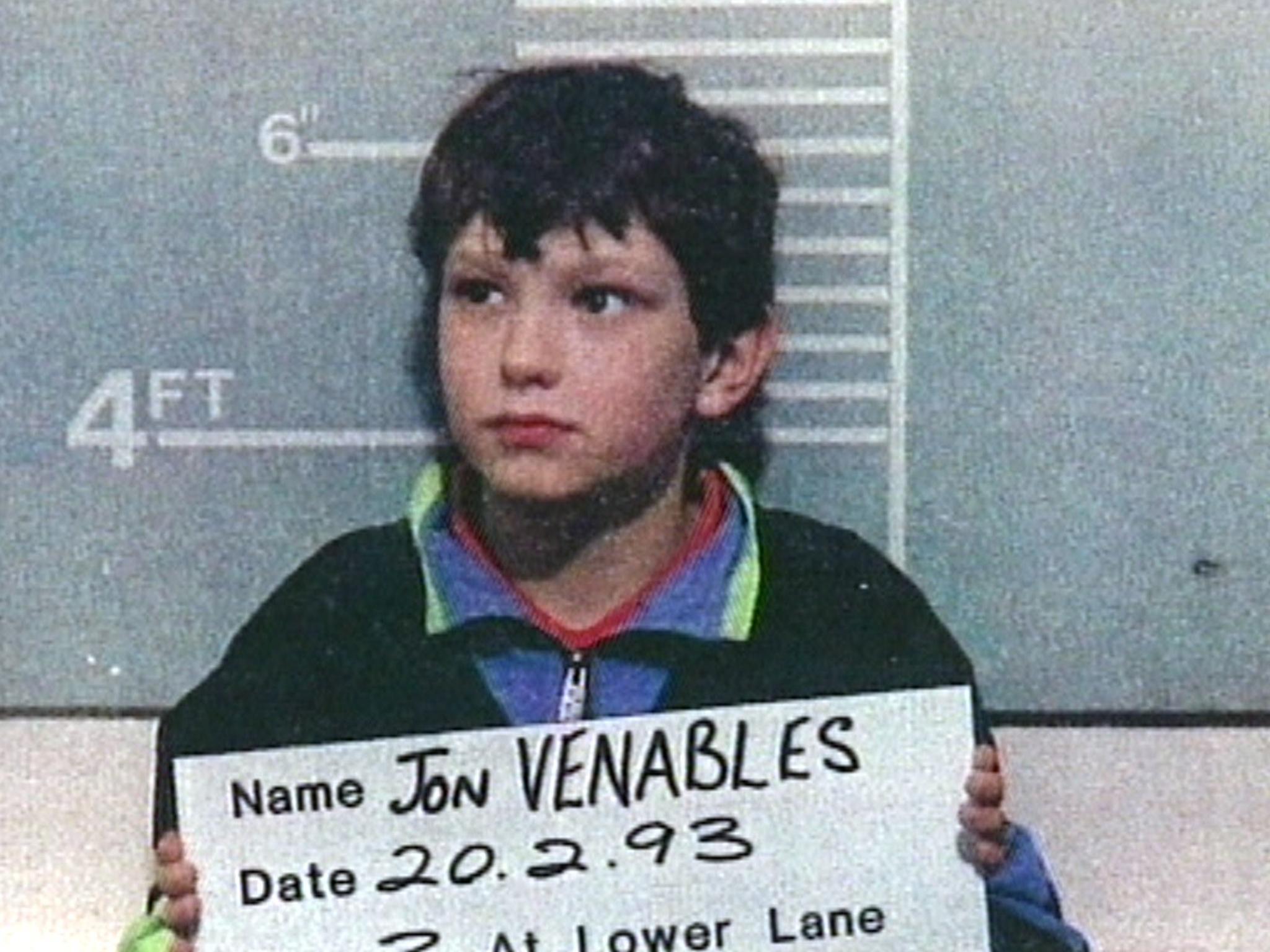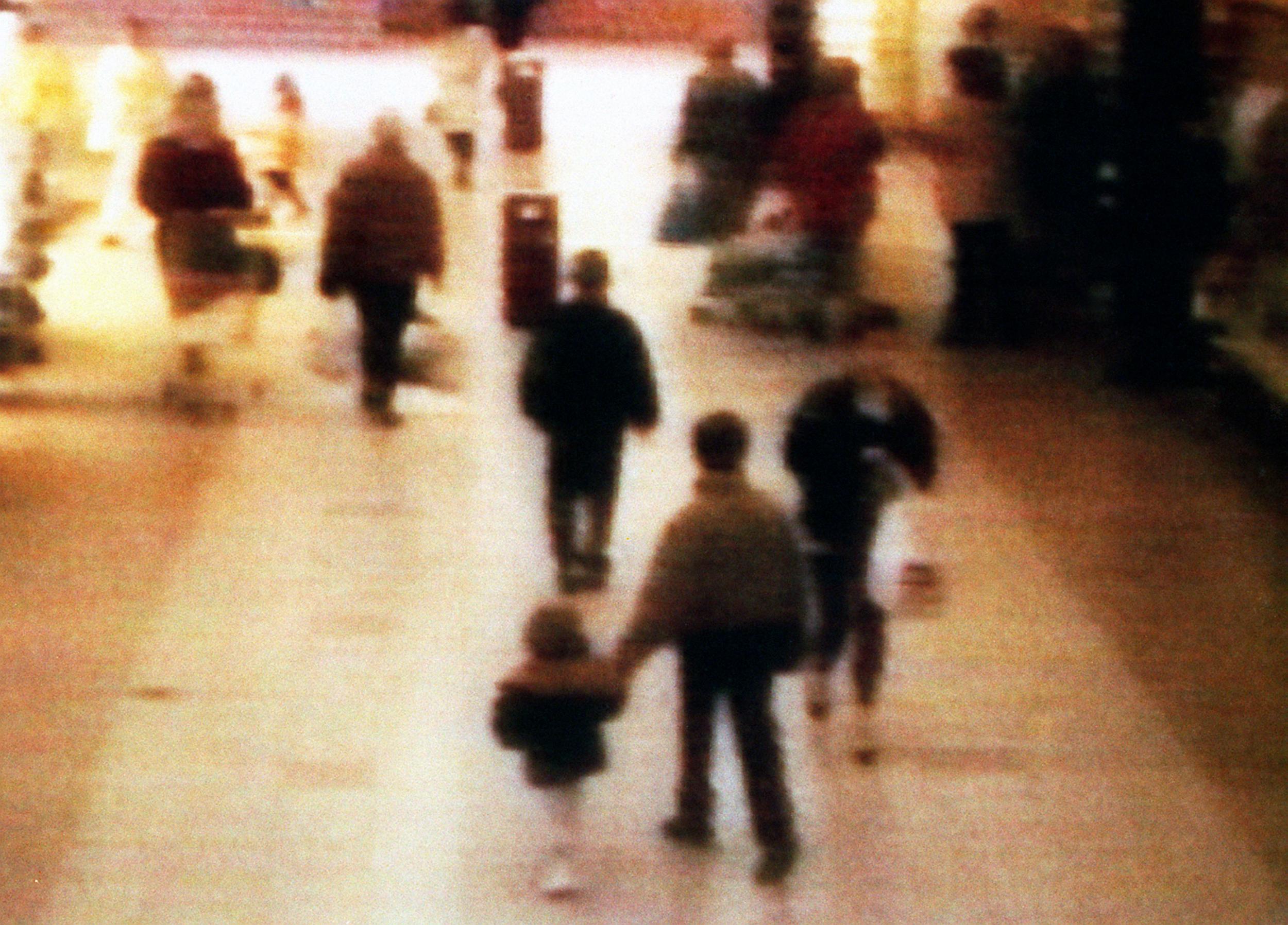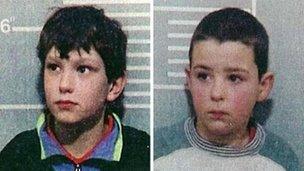James Bulger: 25 years on from the murder that shook Britain
Some crimes resonate more than others. A quarter of a century on and the toddler’s brutal and senseless death has seeped into our consciousness like no other

Holding a board with his name and the date of his arrest on 20 February 1993, Jon Venables stands at just over 4ft 6in as he looks away from the camera in his police mugshot – a picture that has become synonymous with one of the most notorious crimes in British criminal history – the murder of toddler James Bulger.
Venables was aged 10 when it was taken, and the picture reappeared in numerous media outlets last November, including The Independent, when he was reportedly sent back to prison after child abuse images were found on his computer.
The image, together with the mugshot of fellow child killer Robert Thompson, also 10 at the time of the crime, is one of only a handful available of the pair. But almost a quarter of a century since they led the toddler to his death, the murder they committed continues to resonate with British society.
James had been out with his mother, Denise Fergus, formerly Bulger, at the New Strand shopping centre, in Bootle, Merseyside.
As she placed an order at the butcher’s shop, she “believed James was by her side when she was being served – but when she looked down, he was gone”, the subsequent murder trial at Preston Crown Court heard.
Just two minutes later, Venables and Thompson were caught on CCTV leading him away, hand in hand.
“One sees Mothercare and we see James being led away by the two killers,” David Wilson, emeritus professor of criminology at Birmingham City University, tells The Independent. “For all the world it looked like an innocent setting.
“The fact that there is a visual image about what was going to happen to that little boy, I think, was the beginning of allowing that crime to seep into our consciousness in a way that other crimes did not.”
Meandering across Liverpool, the boys were seen by 38 people, dubbed “the Liverpool 38” by the tabloids. Most assumed he was their younger brother. A couple of people challenged Thompson and Venables, who told them they were taking James to a police station.
“There is a community or public witnessing of what was happening and being disquieted about it, but for various reasons not being able to prevent what was about to happen,” Professor Wilson says.
Their only moment of hesitation came when they faced the Walton Lane police station, but they quickly continued their journey, leading the toddler up a steep bank to a railway line.
There, the boys threw blue modelling paint, which they had earlier shoplifted while playing truant, into James’s left eye. They kicked and stomped on him, threw bricks and stones at him and placed batteries in his mouth.
Finally, they dropped a 22lb iron bar onto the toddler’s head, causing 10 skull fractures. Then they laid him across the railways tracks, weighing his head down with rubble in the hope that his death would appear to be an accident. Bulger’s body would be severed by a train.
Home office pathologist Dr Alan Williams would later testify that he counted 22 bruises, splits and grazes on James’s face and head, and 20 more wounds on his body. He was unable to say which had been the fatal blow.

In the immediate aftermath of his disappearance, police scoured the area and examined the CCTV footage. When they pinpointed the moment James was taken, they released the still images from it, which would become forever associated with the dreadful crime.
Denise and her husband, Ralph Bulger, James’s father, made an emotional appeal for their son’s return.
But two days after his disappearance, the toddler’s body was found, just 200 yards from the police station.
The “biggest thing”, Detective Superintendent Albert Kirkby, who led the investigation, subsequently told the Liverpool Echo, “was having to accept the possibility that the people who had murdered James were going to be very young”.
He added: “We thought, from what happened with the body, that it had to be the work of an adult. It was very difficult to get our minds around that potential situation that we could be dealing with two young boys.”
A combination of the footage and various sightings led them to Venables and Thompson.
His colleague Detective Sergeant Phil Roberts told the Powys County Times that Thompson’s brother said they had “just been to lay flowers” at a memorial for James just before Thompson was arrested.
“When I heard that, the first thing I thought was ‘it can’t be him’,” DS Roberts said.
“He totally denied everything,” the now retired police veteran added. “He never showed any remorse during any stage of the interview. I understand Venables did.
“He acted whiter-than-white in interview and in many ways he was very clever in a conniving, streetwise sort of way, but in the end he shot himself in the foot by giving me a detailed account of what James Bulger was wearing.
“This is where we thought ‘we’ve got him’ because no 10-year-old would remember what he was wearing in such detail unless they had reason to.”
Officers charged the boys six days after James disappeared.

As The Independent’s Bryan Appleyard reported from outside South Sefton magistrates’ court in Bootle on 22 November, violent scenes erupted as huge crowds gathered outside.
“Kill the bastards,” they cried, “A life for a life.” Photographs the next day showed distorted faces, arms flung wide in anguish and imprecation.
“They’ve got to take out their frustration on someone,” a policeman told Appleyard at the scene, “you can understand it.”
Their fury had been whipped up by tabloid newspapers and politicians.
Tony Blair, who had just taken over as Shadow Home Secretary, “was very aware of the need to camp New Labour tents on the territory that had historically been seen as somewhere that the Conservatives would camp”, says Professor Wilson.

“Suddenly the ratcheting up of crime and punishment language politically became a bit more febrile. So aside from Blair making comments, you then get John Major responding.”
Calling for a tough stance, the then Prime Minister said that society needed “to condemn a little more, and understand a little less”.
Professor Wilson adds: “That served to invest the crime with meaning that became political and party political. Who was going to out tough the other... New Labour or The Conservatives?”
There would be similar violent scenes outside Preston Crown Court that November, with abuse screamed at the police, press and any passing vans that might contain the defendants.
“Everybody tended to think Thompson was the ringleader, just by looking at him in court,” says Blake Morrison, an author who covered the trial and eventually wrote a book about it called As If.
“He seemed much tougher. He stared out journalists, whereas Venables was very emotional and cried. He seemed the weaker. But that was just the perception in an adult court.
“We know that Venables had a temper and had been known to lose control and had done some pretty weird things, so in reality I think it is just as likely that he was the instigator.”
Following the 17-day trial, Presiding Judge Sir Michael Morland bowed to public pressure and named the boys, who until then had only been known as Boy A and Boy B.
He said they were guilty of “unparalleled evil and barbarity”, before ordering them to be detained at Her Majesty’s pleasure, with a minimum tariff of eight years.
The “Devil Himself Couldn’t Have Made A Better Job of Two Fiends”, The Sun’s headline read the next day, while the the Daily Star asked: “How Do You Feel Now, You Little Bastards?”
A Daily Mirror headline said the boys were “Freaks of Nature”; politicians damned the boys as “worthless” and “evil”.
“I think the fact that they were given names made a big difference… If they hadn’t been there just couldn’t be as much to write and speculate on,” says Morrison.
Public fascination with the case comes from the fact that “everyone wants to understand why, apart from John Major”, the author adds, whose new novel, The Executor, is out in March.
“It is very unusual to have children murdering children so the rarity factor was one thing,” he says.
“When you have got two people who are involved in a crime, especially two so young, inevitably there is psychological speculation. There is with any murderer, but there is an increased amount of it because you are thinking: ‘Was one of them the ringleader or the other one?’ You wonder how the chemistry between them worked.”
He adds that he would cite “dysfunctional families where there has been divorce, breakup, acrimony, alcoholism, neglect as children [and] truancy on a vast scale” as factors in the crime.
“The fact that Thompson and Venables were held back for a year in school because they had August birthdays and they weren’t performing well meant they formed a team together,” he says. “There was resentment of younger siblings in both cases, which made them not people to trust with a small child.”
The case would take a personal toll on Ralph and Denise Bulger, who split the year after the murder, in 1994. Denise would go on to marry electrician Stuart Fergus in 1998. The pair have three children together and she set up the James Bulger Memorial Trust in her murdered son’s name.
Ralph eventually settled with partner Natalie McDermott. They had a baby daughter in 2013.
The case would return to the public eye on numerous occasions over the following two decades as the boys’ sentences were increased and then reversed to the original eight years.
Before their release in June 2001, the killers won an unprecedented court order from the High Court, which granted them anonymity for the rest of their lives.
Dame Butler-Sloss, the president of the High Court’s Family Division, said there was a “real possibility of serious physical harm and possible death from vengeful members of the public or the Bulger family”.
The Parole Board then ruled that the boys were no longer a threat to public safety and could be released as their minimum tariff had expired.
At the time, David Blunkett, then Home Secretary, made it clear that they should be equipped to lead purposeful lives. “They have to be trained, educated and engaged in independent living, otherwise they will become more of a risk in later life,” he said.
Since then, Robert Thompson has disappeared into anonymity. Three years after his release, Denise Fergus told the now defunct News of the World that she had tracked him down, but she was “paralysed with hatred” and could not bring herself to confront him.
Knowing where he was had nonetheless given her “a sense of power”, she said.
Venables, however, has continued to make headlines. He went on to offend again after his first release from prison, including arrests for affray and cocaine possession in 2008.
He pleaded guilty to downloading images of child abuse in 2010 and was granted parole in 2013, which saw him handed a second new identity.
Then in November, now 35, he was reportedly sent back to prison after child abuse images were found on his computer. “Here we go again,” Denise tweeted shortly after the news broke.
As the case continues to make headlines, the public’s fascination with it remains.
“It’s one of the turning points in terms of cultural sensibilities about children who commit crime and how we manage those children who commit crime,” says Professor Wilson.
“There were children who killed both before and after Thompson and Venables. This case has found a place that is more embedded in terms of how we think about ourselves and we think about childhood and how that space has to be managed.”
Blake Morrison, meanwhile, says the case is “up there with Peter Sutcliffe”, commonly referred to as the “Yorkshire Ripper”, the Moors murders and Fred and Rosemary West, in terms of its impact on British public consciousness.
But in the 25 years that have passed, he says: “I don’t think we have learnt a lot.
“The fact is that at 10, the age of criminal responsibility remains shockingly low, which puts us way out of line with other countries in the world, certainly those in Europe.
“If there was a similar crime today, I’m not sure we’ve learnt enough to deal with the kind of vilification and demonisation, and whether we’ve learnt that children in a courtroom with an international media presence isn’t the right way to go about looking at that crime, drawing the consequences and deciding on treatment.”
He adds: “There isn’t much reason to feel things have changed or we’ve learnt our lessons or we’ve become better. There are few measures that have been put in place to protect children like appearing on screen, but we haven’t learnt enough.”